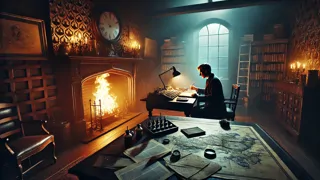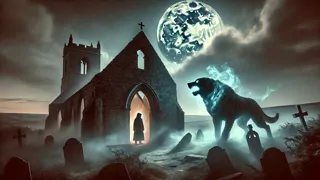Introduction
The moor wind whispered secrets in a language older than any living memory, carrying the faintest echoes of a curse that had haunted the Baskerville family for generations. In the heart of London, Sherlock Holmes sat by the flickering hearth at 221B Baker Street, studying the aged manuscript that Dr. James Mortimer had brought to him with the urgency of a man fearing an unseen predator. The parchment’s margins bore cryptic warnings of a hound with burning eyes, its howl capable of instilling terror even in the bravest soul. Dr. Watson, by Holmes’s side, listened as Mortimer recounted the nightmare of Sir Charles Baskerville’s death on the mist-enshrouded moors of Dartmoor—a death that bore all the hallmarks of a supernatural beast and none of rational explanation. If this beast existed, it must have a human hand guiding its steps, a motive that lay buried beneath layers of superstition and fear. Holmes examined each line and discolored blotch on the parchment by the lamp’s glow, his sharp eyes missing no nuance in the doctor’s narrative. The doctor had come to London seeking Holmes’s singular expertise in unraveling the maddening knot of rumor, despair, and death. The detective’s lips curved in a thin smile: a case steeped in Gothic lore was precisely the one that tested every principle of his art. With resolve, Holmes announced that at dawn they would depart for Baskerville Manor, prepared to navigate the treacherous border where myth met malice and bring reason to the shadows of Dartmoor.
An Ominous Inheritance
On a fog-laden evening in Baker Street, Dr. James Mortimer entered the sitting room with a tremor in his voice and dread in his eyes. He unfolded an ancient manuscript, its edges frayed and stained by time, and laid it upon the desk before Holmes and Watson. The parchment described a phantom hound, its eyes blazing crimson, that haunted the moors of Dartmoor and preyed upon the heirs of Baskerville Manor. Mortimer’s account trembled between fact and legend: his late friend Sir Charles Baskerville had died under unexplained circumstances, his face twisted in horror, and local peasants claimed to have heard the baying of a monstrous creature at night. Watson’s gaze darted nervously to the window where the London fog seeped between the panes, as though eager to carry news of the curse back to the moors. The hush of the room felt unnatural, broken only by the crackle of the hearth and Mortimer’s uneven breathing. Holmes tapped a gloved finger on the map of Dartmoor spread across the table, each moorland marker a promise of danger and myth.

Mortimer continued, his voice low and urgent: Sir Charles had been lured onto the moor by a lantern’s glow that appeared just beyond the ruined chapel on the night of his death. Despite the company of loyal servants and protective warnings, his heart failed him at the sight of a hulking, spectral beast streaked with phosphorescent fur. Daylight revealed nothing but footprints vanishing at the edge of a rocky outcrop, and the dog’s howl remained an echo in local lore. Holmes requested every witness’s statement, detailed maps of the region, and any newspaper cuttings that recounted similar tragedies over the past centuries. Watson felt the weight of Mortimer’s gaze imploring the detective to unravel the enigma before another tragedy struck the Baskerville line.
After reviewing the evidence, Holmes declared that he would accompany Mortimer to Baskerville Manor at first light. Watson, eager for the adventure but wary of the legend’s grip upon the locals, volunteered to join the investigation and take charge of the doctor’s examination. Holmes warned that superstitions would cloud judgment, and only by scrutinizing each clue—no matter how spectral—could they dispel the darkness that shrouded the moor. London’s gray streets felt a world away as the trio prepared for departure. The crack of the carriage wheels over cobblestone streets echoed the distant rumble of unseen hounds, setting the stage for a journey deeper into the heart of a mystery that bridged the rational and the supernatural.
Footsteps on the Moor
At sunrise, the carriage rattled toward Baskerville Manor, its battered silhouette emerging through swirling mists that clung to the heather like ghostly shrouds. A heavy pall seemed to hang over the estate, its ancient walls stained by centuries of rain and neglect. Mrs. Lyons, the housekeeper, greeted the party with trembling formality, her eyes darting toward the moor beyond the windows. Beneath her stiff veneer, Mortimer caught the tremor of fear as she gestured toward the gallery where Sir Henry Baskerville, the new heir, awaited the arrival of London’s greatest detective. Holmes studied the layout of the grounds—rookeries nestling in gnarled trees, stone bridges arcing over narrow streams, and pathways leading into shadowed bogs. Watson noted the absence of any hounds in the kennels, answering the unanswered question of whether the legend had any basis in living creatures.

In the late afternoon, Holmes and Watson ventured onto the moor to inspect the site of Sir Charles’s demise. The ground was soft and treacherous, soaking their boots as they traced a set of massive canine prints that seemed to vanish at the edge of a peat bog. The detective leaned down, measuring the depth and offset with practiced precision, then followed an erratic path toward a rocky outcrop. Watson’s heart pounded when a low, resonant growl rolled across the moor, followed by a distant, blood-curdling bay. A shiver passed through him as the hairs on his neck stiffened. Holmes signaled silence and raised his magnifying glass to examine tufts of coarse, dark fur caught on a bramble. The moor wind carried away any faint smell, leaving only the memory of a predator that walked on mist and myth.
Night settled early and waxed eerie as fog enveloped the estate, isolating the manor in a cloak of grey. Sir Henry joined them at dinner, his polite curiosity masking a hidden dread, while Holmes noted the blank expression of the Butler who placed each dish as though compelled by habit and fear. Watson caught sight of a note pinned to his plate: ‘Leave this place before you hear the hound’s call.’ Holmes’ eyes flickered with interest as he smoothly pocketed the warning. ‘Someone wishes to frighten our guest into flight,’ he murmured. Soon, the heavy iron gates of the yard clanged open and shut, though no living soul was in sight. The moor lay silent, as though waiting—to judge or to strike.
Revelation at Midnight
Holmes insisted on a midnight vigil near the old chapel ruins, where legend held the phantom hound roamed. Watson, bundled against the chill, peered through his binoculars as lantern light flickered among crumbling stones. The manor’s shadows swayed in time to the wind’s sigh. At the darkest hour, they heard a low whistle echo from the distant heath. Holmes raised his hand, and they crouched behind a collapsed wall. A hulking shape emerged, its coat luminous with phosphorescent streaks, eyes ablaze like twin coals. The creature snarled, its breath steaming in the cold air. Watson’s pulse thundered; he glimpsed a man’s silhouette perched on a nearby outcrop, guiding the beast with a signal band.

As the hound charged, Holmes flung a grapnel, startling both beast and handler. Watson sprinted forward to shield Sir Henry, shouting instructions. The man on the crag fell back, revealing himself as Selden, the escaped convict whose family betrayal had fueled Mortimer’s tale. He tumbled with a cry, pinned by the hound’s weight, just as Holmes tackled the creature’s neck and pinned its muzzle. Under the detective’s steel gaze, Selden confessed: he had stoked the Baskerville curse to extract a reward, using phosphorescent paint and preternatural training to deceive locals and investigators alike. The monstrous facade fell away under Holmes’s relentless inquiry.
In the morning light, Holmes and Watson led Sir Henry through the dewy grass toward safety. The manor’s doors opened to welcome a new dawn, the thunder of one anxious night giving way to hope. Holmes explained each detail: the orchestrated howls, the painted skull mask atop the hound’s head, the forged manuscript margins. Mortimer thanked the detective with a solemn nod, reassuring that the Baskerville line would endure beyond superstition. Watson remarked on how thin the veil between myth and reality had grown on those moors. Holmes replied that reason would always shine through the darkest fables. As they prepared to return to London, Sir Henry placed a heavy coin in Holmes’s hand—and the hound, once a symbol of terror, became nothing more than a memory on muddy ground.
Conclusion
In the end, the shadow of the Baskerville hound was banished by clear reasoning and courageous action, rather than by any supernatural force. Watson chronicled the events in his journal with reverence for Holmes’s unwavering intellect, while Sir Henry Baskerville regained peace of mind and the rightful inheritance of his ancestral home. The moors, once alive with eerie howls, fell silent save for the rustle of grass in the wind and the distant call of wild ponies. Mortimer marveled at how fragile the line between legend and greed could become when desire overshadowed reason. Holmes, with a hint of a rare smile, reminded his companion that every mystery, no matter how dark its origins, could be unraveled through patience, observation, and the relentless pursuit of truth. Though the memory of glowing eyes and thunderous baying would linger in the hearts of local villagers, rational explanations had dispelled a centuries-old nightmare. Visitors to the manor would walk its halls without trepidation, and the legend of the hound would transform into a cautionary tale about the power of human cunning and the perils of unchecked belief. As Holmes and Watson departed, the manor’s silhouette receded into the morning mist, leaving behind a legacy stronger than any curse. In the quiet that followed, the world seemed a little safer, guided by the assurance that when terror takes shape in darkness, the light of reason can always shine through.


















